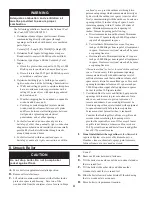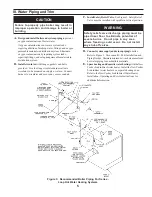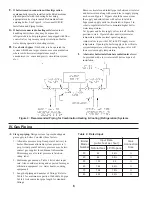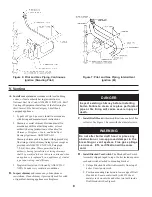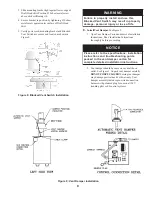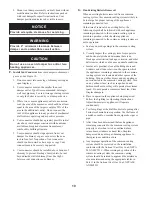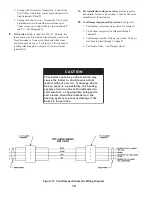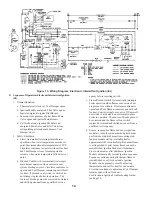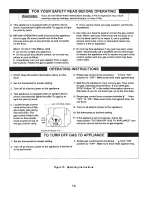
10
3. Mount vent damper assembly on draft hood without
modification to either. Refer to instructions packed
with vent damper for specific instructions. Vent
damper position indicator to be visible to users.
E
C
I
T
O
N
.
g
n
i
c
i
v
r
e
s
r
o
f
e
c
n
a
r
a
e
l
c
e
t
a
u
q
e
d
a
e
d
i
v
o
r
P
G
N
I
N
R
A
W
n
e
e
w
t
e
b
e
c
n
a
r
a
e
l
c
m
u
m
i
n
i
m
"
6
e
d
i
v
o
r
P
.
n
o
i
t
c
u
r
t
s
n
o
c
e
l
b
i
t
s
u
b
m
o
c
d
n
a
r
e
p
m
a
d
N
O
I
T
U
A
C
o
w
t
l
o
r
t
n
o
c
o
t
r
e
p
m
a
d
t
n
e
v
e
n
o
e
s
u
t
o
n
o
D
.
s
e
c
n
a
i
l
p
p
a
g
n
i
t
a
e
h
F.
Install Vent Connector
from vent damper to chimney or
gas vent. See Figure 10.
1. Do not connect into same leg of chimney serving an
open fireplace.
2. Vent connector must not be smaller than vent
damper outlet. Type B is recommended, but single-
wall vent pipe may be used. Arrange venting system
so only the boiler is served by vent damper device.
3. Where two or more appliances vent into a common
vent, the area of the common vent should be at least
equal to the area of the largest vent plus 50% of the
area in the additional vent(s). Do not connect the
vent of this appliance into any portion of mechanical
draft systems operating under positive pressure.
4. Vent connector should have greatest possible initial
rise above vent damper consistent with headroom
available and required clearance from adjacent
combustible building structure.
5. Vent connector should slope upward from vent
damper to chimney or gas vent not less than one
inch in four feet. No portion of vent connector
should run downward or have dips or sags. Vent
connector must be securely supported.
6. Vent connector should be installed above bottom of
chimney to prevent blockage. Inserted into but not
beyond inside wall of chimney liner. Seal tight
between vent connector and chimney.
G.
If an Existing Boiler is Removed:
When an existing boiler is removed from a common
venting system, the common venting system is likely to
be too large for proper venting of the appliances
remaining connected to it.
At the time of removal of an existing boiler, the
following steps shall be followed with each appliance
remaining connected to the common venting system
placed in operation, while the other appliances
remaining connected to the common venting system are
not in operation:
a. Seal any unused openings in the common venting
system.
b. Visually inspect the venting system for proper size
and horizontal pitch and determine there is no
blockage or restriction, leakage, corrosion, and other
deficiencies which could cause an unsafe condition.
c. Insofar as is practical, close all building doors and
windows and all doors between the space in which
the appliances remaining connected to the common
venting system are located and other spaces of the
building. Turn on clothes dryers and any appliance
not connected to the common venting system. Turn
on any exhaust fans, such as range-hoods and
bathroom exhausts, so they will operate at maximum
speed. Do not operate a summer exhaust fan. Close
fireplace dampers.
d. Place in operation the appliance being inspected.
Follow the Lighting (or Operating) Instructions.
Adjust thermostat so appliance will operate
continuously.
e. Test for spillage at the draft hood relief opening after
5 minutes of main burner operation. Use the flame of
a match or candle, or smoke from a cigarette, cigar or
pipe.
f. After it has been determined that each appliance
remaining connected to the common venting system
properly vents when tested as outlined above,
return doors, windows, exhaust fans, fireplace
dampers and any other gas-burning appliance to
their previous condition of use.
g. Any improper operation of the common venting
system should be corrected so the installation
conforms with the
National Fuel Gas Code
, NFPA
54/ANSI Z223.1. When resizing any portion of the
common venting system, the common venting
system should be resized to approach the minimum
size as determined using the appropriate tables in
Part 11 in the
National Fuel Gas Code
, NFPA 54/
ANSI Z223.1.
Содержание CG-A 30
Страница 16: ...16 Figure 15 Operating Instructions ...
Страница 17: ...17 Figure 16 Lighting Instructions ...
Страница 20: ...20 ...
Страница 21: ...21 ...




